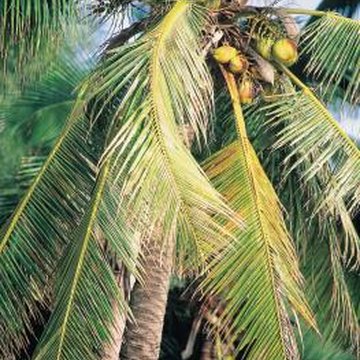
Coconut fruits turn from yellow or green to brown as they mature.
The coconut palm (Cocos nucifera) is among the most extensively used trees worldwide and strongly associated with tropical landscapes. This plant, hardy in U.S. Department of Agriculture plant hardiness zone 10 and warmer areas, serves as an excellent specimen planting or background tree and may, particularly when it is young, offer potential as a container specimen. Multiple cultivars of the coconut palm offer varying degrees of trunk crookedness, leaf petiole and fruit colors, growth rates, adaptability to soil conditions and levels of disease resistance.
Distribution and Climate
The origin of the coconut palm tree is not known with certainty, as this plant was widely spread throughout the tropics long ago, although it may be native to the South Pacific or the Malay Archipelago. It is distributed throughout tropical and some subtropical regions and grows best where the minimum average temperature is at least 72 degrees Fahrenheit and the annual rainfall amount is at least 30 to 50 inches. Coconut palm trees require full sunlight and well-drained soil, but can tolerate brackish soil and high winds.
Uses
The coconut is the most cultivated nut in the world and a very important commercial crop in many tropical countries. The nut meat, coconut oil from the dried meat and milk are used for drinks, cooking, cosmetics and numerous other types of products. Unopened flowers can potentially produce coconut molasses and the hard-grained shell of the nut is carved into practical utensils and ornamental objects. Trunk wood is used for building and ornamental purposes and the coir from the fruit husk is woven for fabric or ropes.
Trunk and Leaves
The coconut palm tree has a single, smooth columnar trunk and can grow 50 to 100 feet tall, depending on the cultivar. The trunk is light grayish-brown in color, sometimes swollen at the base and usually gracefully curved or leaning. Leaves of the coconut palm tree are feather shaped, growing up to 18 feet long with individual lance-shaped leaflets that are 2 to 3 feet long and 2 to 3 inches wide. The evergreen leaves grow in a terminal crown at the top of the trunk.
Flowers and Fruits
The coconut flowers emerge from canoe-shaped sheaths within the crown of leaves. Each inflorescence is 2 to 3 feet long and contains light yellow female flowers near the base of the branchlet and smaller male flowers at the end of the branchlet. The female flowers mature into a fruit 15 inches long and 12 inches wide. The fruit has a thick, fibrous husk around a nut about 6 to 8 inches wide and 10 to 12 inches long. Within the shell of this nut is a fleshy white layer known as the coconut's meat or copra and a water liquid known as coconut milk that is absorbed by the meat as the nut ripens. A healthy, mature coconut palm will produce about 50 nuts per year, each weighing approximately 6 pounds.
Propagation
Coconut palms are propagated only from seed. The seeds, or coconut nuts, are ready for planting when they make a sloshing sound upon shaking. Following soaking in water for two or three days, the nut is placed on its side or with the pointed end down in a well-drained site or container with well-drained growing medium and covered about halfway with sand or mulch. Germination occurs best with regular moisture and temperatures between 90 and 100 degrees Fahrenheit and takes three to six months. Coconut palms grow rapidly and can begin to bear fruit after as few as five years.
Author: Angela Ryczkowski
No comments:
Post a Comment